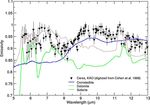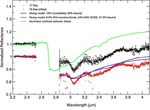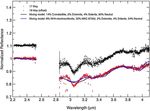The surface composition of Ceres: Discovery of carbonates and iron-rich clays
←
→
Page content transcription
If your browser does not render page correctly, please read the page content below
Icarus 185 (2006) 563–567
www.elsevier.com/locate/icarus
Note
The surface composition of Ceres:
Discovery of carbonates and iron-rich clays
A.S. Rivkin a,∗,1 , E.L. Volquardsen b,1 , B.E. Clark c,1
a JHU Applied Physics Laboratory, 11100 Johns Hopkins Road, Laurel, MD 20723, USA
b Institute for Astronomy, University of Hawai’i, 640 N. Aohaku Place, Hilo, HI 96720, USA
c Ithaca College, Department of Physics, Ithaca, NY 14850, USA
Received 21 June 2006; revised 16 August 2006
Available online 23 October 2006
Abstract
We present observational evidence that carbonates and iron-rich clays are present on the surface of Ceres. These components are also present in CI chondrites and
provide a means of explaining the unusual spectrum of this object as well as providing potential insight into its evolution.
© 2006 Elsevier Inc. All rights reserved.
Keywords: Asteroid Ceres; Asteroids, composition; Infrared observations; Spectroscopy
Ceres is the largest object in the main asteroid belt. Its spectrum in the Jones et al., 1990; Rivkin et al., 2003), but there has been no agreement about
visible and near-IR is typical of C-class asteroids and consistent with carbona- the specific composition of the species responsible for the band on Ceres. Ceres’
ceous chondrites. It has an absorption band near 3 µm diagnostic of hydrated 3-µm band shape is unlike that of most C-class asteroids and is not known to
minerals, as detailed below. Ceres has been the subject of increased attention occur in meteorites (Sato et al., 1997). This can be seen in Fig. 1, which shows a
of late, with our knowledge of this body increasing rapidly since its identi- reflectance spectrum of the CM meteorite Murchison from the ASTER spectral
fication as a target of NASA’s Dawn spacecraft mission, and with its reclas- library (http://speclib.jpl.nasa.gov) as well as new spectra of Ceres described
sification as a dwarf planet in 2006 by the International Astronomical Union below. The spectrum of Murchison is typical of most hydrated carbonaceous
(IAU). Thermodynamic modeling of Ceres’ evolution (McCord and Sotin, chondrites and most C-class asteroids with a 3-µm band (including 2 Pallas,
2005) and subsequent shape measurements using HST (Thomas et al., 2005; for instance). Due to an additional absorption centered near 3.05 µm (first ad-
Erard et al., 2005) support the hypothesis that Ceres is differentiated and may dressed by Lebofsky et al., 1981) and other apparent absorptions beyond that
have a subsurface ocean, reviewed by McCord et al. (2006). Consensus as to the wavelength, Ceres does not exhibit the roughly linear rise beyond 2.9 µm seen
exact surface composition of Ceres remains elusive, however. Work in the 1970s in Murchison.
and 1980s concluded that Ceres was similar to carbonaceous chondritic mete- The first observations of the 3.05 µm band were interpreted as indicative
orites largely based on overall characteristics such as albedo and spectral slope of water ice frost (Lebofsky et al., 1981), which is only marginally stable on
(Johnson and Fanale, 1973; McCord and Gaffey, 1974; Lebofsky et al., 1981; Ceres. Later work suggested ammoniated clays as a better fit (King et al., 1992),
Larson et al., 1983; and others). McCord and Sotin (2005) provide an in-depth though such minerals have never been seen in meteorites. More recent obser-
review of early spectroscopic work in the visible and near-infrared regions. vations have been interpreted as matching irradiated organic materials in the
An absorption near 3 µm, diagnostic of hydrated or hydroxylated species on presence of ice (Vernazza et al., 2005). Most hydrated C-class asteroids are con-
airless bodies, has been known on Ceres for nearly 30 years (Lebofsky, 1978; sistent with CM meteorites but, because some other asteroids have been found
with Ceres-like band shapes (Rivkin et al., 2003), understanding the source of
the 3-µm band has implications beyond Ceres.
To further study this problem, we obtained 2.2–4.0 µm spectroscopic ob-
* Corresponding author. servations of Ceres using the long-wavelength dispersed (LXD) mode of the
E-mail addresses: andy.rivkin@jhuapl.edu (A.S. Rivkin), SpeX instrument at the NASA Infrared Telescope Facility (IRTF) on Mauna
elv@duke.ifa.hawaii.edu (E.L. Volquardsen), bclark@ithaca.edu (B.E. Clark). Kea in Hawaii on May 17 and 18, 2005. The spectra are averages of more
1 Visiting Astronomer at the Infrared Telescope Facility, which is operated by than 120 min of total integration time on May 17th and 80 min of integra-
the University of Hawaii under Cooperative Agreement No. NCC 5-538 with tion time on May 18th. These data span a complete rotation of Ceres (9.075 h).
the National Aeronautics and Space Administration, Science Mission Direc- Roughly an hour of integration time was obtained for each of two standard stars
torate, Planetary Astronomy Program. on each night. The data were reduced using Spextool software provided by the
0019-1035/$ – see front matter © 2006 Elsevier Inc. All rights reserved.
doi:10.1016/j.icarus.2006.08.022564 Note / Icarus 185 (2006) 563–567
(a)
(b)
Fig. 1. 2.2–4.1 µm spectra of Ceres from 17 May and 18 May 2005, normalized to 1 at 2.2 µm. The 18 May spectrum (black) is offset from the 17 May spectrum
for clarity. Also shown as solid lines are model spectra generated using a Hapke theory-based mixing model. These models use a carbonaceous chondrite, a neutral
material, carbonates, and either an ammonium-bearing or iron-rich phyllosilicate as end-members. The top panel (a) shows the best-fit models using all of the
components, indicating 6% carbonates. The bottom panel (b) removes the carbonates from the best-fit models, showing the requirement for carbonates in an
acceptable fit. The bottom panel also shows the CM meteorite Murchison, showing the very different band shapes between it and Ceres. The end-member spectra
were obtained from the RELAB and ASTER databases and contributed by Trude King. Data between 2.52 and 2.85 µm were omitted due to excessive spectral
contamination from water in the Earth’s atmosphere.
IRTF (Cushing et al., 2003). Following normal Spextool reduction procedures, Fig. 1 shows the reflectance spectra of Ceres at 2.2–4.0 µm from 17 and 18
the data were fit with an atmospheric model to remove residual telluric effects May 2005. The gap in data from ∼2.55–2.85 µm is due to saturated water bands
(similar to that done for shorter-wavelength data by Sunshine et al., 2004) and from the Earth’s atmosphere. The Ceres spectra are offset from one another for
corrected for the influence of thermal flux (Rivkin et al., 2003). clarity.Note / Icarus 185 (2006) 563–567 565
The broad 3-µm band in the Ceres spectra has several sub-bands, centered components. End-member spectra were obtained from the RELAB and ASTER
near 3.05, 3.3–3.4, and 3.8–3.9 µm. The 3.05-µm band has been attributed to spectral libraries, except for the ammonium-bearing montmorillonite spectrum
a water ice frost, ammoniated phyllosilicates, and irradiated organic material, (T. King, personal communication). All end-members were measured at fine
as mentioned above. Hydrated Fe-rich phyllosilicates can have band minima or (566 Note / Icarus 185 (2006) 563–567
comparisons to aid in interpretation of the spectral features in the KAO spec- Acknowledgments
trum. Included in Fig. 2 are cronstedtite and dolomite (reflectance spectra con-
verted to emissivity using Kirchhoff’s Law). These two minerals, not previously
This work was supported by a grant from the NASA Planetary Astron-
considered by Cohen et al. (1998), do an excellent job of matching the peaks
omy program. Thanks to the native peoples of Hawaii for allowing their sacred
seen in Ceres’ mid-IR spectrum: the 9.5 µm peak is well matched by the cron-
mountain to be used for astronomical research. Thoughtful reviews by Tom Mc-
stedtite spectrum and the remaining peaks are well matched by the carbonates.
Cord and Larry Lebofsky greatly improved this manuscript. This research has
Carbonaceous chondrites have absorption bands near 6.8 µm that have been at-
made use of NASA’s Astrophysics Data System.
tributed to carbonates (Miyamoto, 1987), and Calvin and King found that iron-
rich clays were a good match to CM chondrite spectra in the mid-IR (though
interestingly, magnesium-rich clays matched their CI spectrum better in this References
wavelength range). We find, as did Cohen et al., that ammoniated saponite spec-
tra are also not consistent with Ceres’ spectrum in the mid-IR. Lizardite (a Mg-
rich phyllosilicate not shown) also fails to match the 9.5 µm peak. We note Benedix, G.K., Leshin, L.A., Farquhar, J., Jackson, T., Theimens, M.H., 2003.
that additional spectra of Ceres in this wavelength region (Dotto et al., 2000; Carbonates in CM2 chondrites: Constraints on alteration conditions from
Lim et al., 2005) are not as suggestive as our data of the presence of cron- oxygen isotopic compositions and petrographic observations. Geochim.
stedtite. However, magnesium-rich and ammonium-bearing clays are also not Cosmochim. Acta 67, 1577–1588.
suggested by those spectra. While the spectrum of Ceres in the 3-µm region Bishop, J.L., Pieters, C.M., Hiroi, T., Mustard, J.F., 1998. Recognition of minor
alone does not lead us to prefer either of Fe-rich or ammonium-rich hydrated constituents in reflectance spectra of ALH 84001 chips and the importance
phyllosilicates over the other, the mid-IR KAO spectrum clearly suggests the for remote sensing on Mars. Meteorit. Planet. Sci. 33, 693–698.
former as a better match. Therefore, considering the spectrum of Ceres as a Bishop, J.L., Banin, A., Mancinelli, R.L., Klovstad, M.R., 2002. Detection of
whole, we prefer Fe-rich phyllosilicates over other candidate materials for the soluble and fixed NH+ 4 in clay minerals by DTA and IR reflectance spec-
3.05 µm band. troscopy: A potential tool for planetary surface exploration. Planet. Space
Ceres represents only the third Solar System object suggested to have car- Sci. 50, 11–19.
bonates, along with Earth and Mars. Carbonates have been seen in protostellar Browning, L.B., Mcsween Jr., H.Y., Zolensky, M.E., 1996. Correlated alteration
dust shells and have been interpreted as having formed through gas phase in- effects in CM carbonaceous chondrites. Geochim. Cosmochim. Acta 60,
teractions with grains or by condensing directly from the solar nebula rather 2621–2633.
than through aqueous alteration (Kemper et al., 2002). In meteorites, they are Calvin, W.M., King, T.V.V., 1997. Spectral characteristics of iron-bearing phyl-
thought to be the products of aqueous alteration. McCord and Sotin (2005) losilicates: Comparison to Orgueil (CI1), Murchison and Murray (CM2).
considered the chemical evolution of Ceres undergoing aqueous alteration and Meteorit. Planet. Sci. 32, 693–701.
concluded that CO2 could have been formed and released. Carbonates would Calvin, W.M., King, T.V.V., Clark, R.N., 1994. Hydrous carbonates on Mars?
easily form in such a scenario. Evidence from Mariner 6/7 infrared spectrometer and ground-based tele-
Tomeoka and Buseck (1985) outlined a multi-step aqueous alteration se- scopic spectra. J. Geophys. Res. 99, 14659–14675.
quence for carbonaceous chondrites. Cronstedtite is the dominant alteration Clark, B.E., Helfenstein, P., Bell, J.F., Peterson, C., Veverka, J., Izenberg, N.I.,
product partway through the sequence, which continues on to make more Domingue, D., Wellnitz, D., McFadden, L., 2002. NEAR infrared spectrom-
magnesium-rich phyllosilicates as the iron enters magnetite. Further laboratory eter photometry of Asteroid 433 Eros. Icarus 155, 189–204.
studies also found cronstedtite to be more indicative of earlier rather than later Clark, B.E., Bus, S.J., Rivkin, A.S., McConnochie, T., Sanders, J., Shah, S., Hi-
stages of alteration (Browning et al., 1996). If Ceres is dominated by iron-rich roi, T., Shepard, M., 2004. E-type asteroid spectroscopy and compositional
rather than magnesium-rich clays, and if there really is, or was, a subsurface modelling. J. Geophys. Res. 109, doi:10.1029/2003JE002200.
ocean, the implication is that the surface of Ceres did not experience aqueous Cohen, M., Witteborn, F.C., Roush, T., Bregman, J., Wooden, D., 1998. Spectral
alteration to completion, despite the apparent availability of large amounts of irradiance calibration in the infrared. VIII. 5–14 micron spectroscopy of the
water, and that its surface had limited exchange with the interior. This is con- Asteroids Ceres, Vesta, and Pallas. Astron. J. 115, 1671–1679.
sistent with the modeling of McCord and Sotin (2005) which predicts ice in the
Cushing, M.C., Vacca, W.D., Rayner, J.T., 2003. Spextool: A Spectral Extrac-
outer 10 km of Ceres would remain frozen, although they note that the frozen
tion Package for SpeX, a 0.8–5.5 micron Cross-Dispersed Spectrograph.
crust would be gravitationally unstable and likely overturn, melt, and refreeze.
Publ. Astron. Soc. Pacific 115, 383–388.
A more detailed consideration of aqueous alteration in the outermost portion of
Dotto, E., and 10 colleagues, 2000. ISO results on bright main belt asteroids:
Ceres’ crust is beyond the scope of this work.
PHT-S observations. Astron. Astrophys. 358, 1133–1141.
Rosenberg et al. (2001) modeled aqueous alteration in CM chondrites and
Endress, M., Zinner, E., Bischoff, A., 1996. Early aqueous activity on primitive
found that cronstedtite forms when precursor material was oxidized rather than
meteorite parent bodies. Nature 379, 701–703.
reduced. As briefly addressed above, there are two different 3 µm band shapes
found on asteroids, one group with band shapes like Ceres, the other similar Erard, S., Forni, O., Ollivier, M., Dotto, E., Roush, T., Poulet, F., Müller, T.,
to 2 Pallas and the CM meteorites (Rivkin et al., 2003). If the two different 2005. The 2004 opposition of Ceres observed with adaptive optics on the
band shapes at 3 µm are caused by differing abundances of hydrated iron-rich VLT. Lunar Planet. Sci. XXXVI. Abstract 1388.
pyllosilicates, then it is possible that this band shape could be used as a proxy Frost, R.L., Kloprogge, J.T., 2000. Vibrational spectroscopy of ferruginous
for the oxidation state of the asteroid belt and, by inference, the solar nebula. smectite and nontronite. Spectrochim. Acta A 56, 2177–2189.
Frost, R.L., Kloprogge, J.T., Ding, Z., 2002. The Garfield and Uley
nontronites—An infrared spectroscopic comparison. Spectrochim.
Conclusions Acta A 58, 1881–1894.
Johnson, T.V., Fanale, F.P., 1973. Optical properties of carbonaceous chondrites
New observations of Ceres in the 2–4 µm spectral region were obtained and their relationship to asteroids. J. Geophys. Res. 78, 8507–8518.
in May 2005 using SpeX on the IRTF. Analysis of thermally-corrected spectra Jones, T.D., Lebofsky, L.A., Lewis, J., Marley, M.S., 1990. The composition
indicates the presence of carbonates at an abundance of 4–6% on Ceres’ surface, and origin of the C, P, and D asteroids: Water as a tracer of thermal evolution
similar to what is seen in CI meteorites. These carbonates are responsible for in the outer belt. Icarus 88, 172–192.
bands in the 3.3 and 3.8–3.9 µm region. Iron-rich phyllosilicates or ammonium- Kemper, F., Jäger, C., Waters, L.B.F.M., Henning, Th., Molster, F.J., Barlow,
bearing phyllosilicates can both account for an absorption band at 3.05 µm, M.J., Lim, T., de Koter, A., 2002. Detection of carbonates in dust shells
but consideration of mid-IR data from Cohen et al. (1998) leads us to favor around evolved stars. Nature 415, 295–297.
iron-rich phyllosilicates. Such minerals, including cronstedtite, are commonly King, T.V.V., Clark, R.N., Calvin, W.M., Sherman, D.M., Brown, R.H., 1992.
found in carbonaceous chondrites and suggest relatively oxidized precursors Evidence for ammonium-bearing minerals on Ceres. Science 255, 1551–
and aqueous alteration that did not go to completion. 1553.Note / Icarus 185 (2006) 563–567 567
Larson, H.P., Feierberg, M.A., Lebofsky, L.A., 1983. The composition of 2 Rivkin, A.S., Davies, J.K., Johnson, J.R., Ellison, S.L., Trilling, D.E., Brown,
Pallas and its relation to primitive meteorites. Icarus 56, 398–408. R.H., Lebofsky, L.A., 2003. Hydrogen concentrations on C-class asteroids
Lebofsky, L.A., 1978. Asteroid 1 Ceres: Evidence for water of hydration. Mon. derived from remote sensing. Meteorit. Planet. Sci. 38, 1383–1398.
Not. R. Astron. Soc. 182, 17–21. Rosenberg, N.D., Browning, L., Bourcier, W.L., 2001. Modeling aqueous alter-
Lebofsky, L.A., Feierberg, M.A., Larson, H.P., Tokunaga, A.T., 1981. The 1.7- ation of CM carbonaceous chondrites. Meteorit. Planet. Sci. 36, 239–244.
to 4.2-micron spectrum of Asteroid 1 Ceres—Evidence for structural water Sato, K., Miyamoto, M., Zolensky, M.E., 1997. Absorption bands near three mi-
in clay minerals. Icarus 48, 453–459. crometers in diffuse reflectance spectra of carbonaceous chondrites: Com-
Lim, L.F., McConnochie, T.H., Bell III, J.F., Hayward, T.L., 2005. Thermal in- parison with asteroids. Meteoritics 32, 503–507.
frared (8–13 µm) spectra of 29 asteroids: The Cornell Mid-Infrared Asteroid Singer, R.B., Roush, T.L., 1985. Effects of temperature on remotely sensed
Spectroscopy (MIDAS) survey. Icarus 173, 385–408. mineral absorption features. J. Geophys. Res. 90, 12434–12444.
Sunshine, J.M., Bus, S.J., McCoy, T.J., Burbine, T.H., Corrigan, C.M., Binzel,
McCord, T.B., Gaffey, M.J., 1974. Asteroids: Surface composition from reflec-
R.P., 2004. High-calcium pyroxene as an indicator of igneous differentiation
tion spectroscopy. Science 186, 352–355.
in asteroids and meteorites. Meteorit. Planet. Sci. 39, 1343–1357.
McCord, T.B., Sotin, C., 2005. Ceres: Evolution and current state. J. Geophys. Thomas, P.C., Parker, J.W., McFadden, L.A., Russell, C.T., Stern, S.A., Sykes,
Res. 110, doi:10.1029/2004JE002244. M.V., Young, E.F., 2005. Differentiation of the Asteroid Ceres as revealed
McCord, T.B., McFadden, L.A., Russell, C.T., Sotin, C., Thomas, P.C., 2006. by its shape. Nature 437, 224.
Ceres, Vesta, and Pallas: Protoplanets, not asteroids. EOS Trans. Am. Geo- Tomeoka, K., Buseck, P.R., 1985. Indicators of aqueous alteration in CM car-
phys. Union 878, 105–109. bonaceous chondrites: Microtextures of a layered mineral containing Fe, S,
Miyamoto, M., 1987. Infrared diffuse reflectances (2.5–25 µm) of some mete- O and Ni. Geochim. Cosmochim. Acta 49, 2149–2163.
orites. Icarus 70, 146–152. Vernazza, P., Mothé-Diniz, T., Barucci, M.A., Birlan, M., Carvano, J.M., Straz-
Moroz, L.V., Arnold, G., Korochantsev, A.V., Wasch, R., 1998. Natural solid bi- zulla, G., Fulchignoni, M., Migliorini, A., 2005. Analysis of near-IR spectra
tumens as possible analogs for cometary and asteroid organics. Icarus 134, of 1 Ceres and 4 Vesta, targets of the Dawn mission. Astron. Astrophys. 436,
253–268. 1113–1121.You can also read




















































